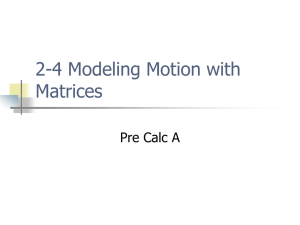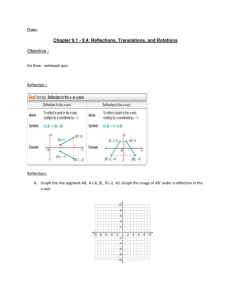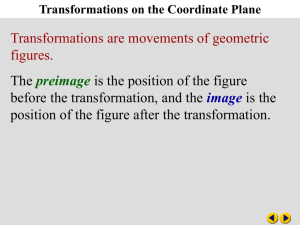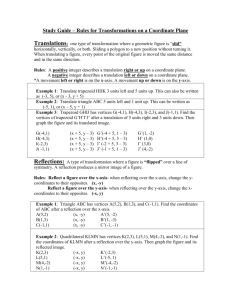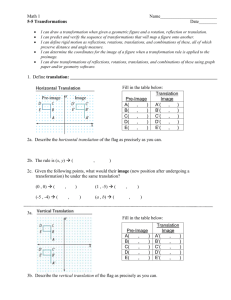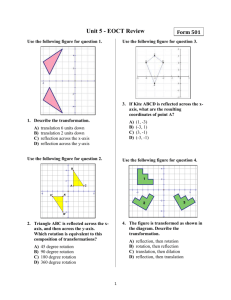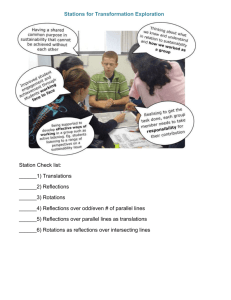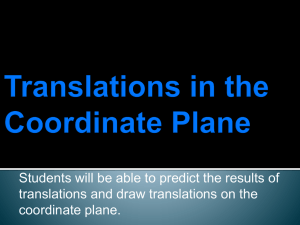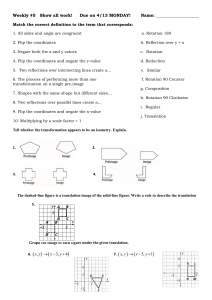Transformations on the Coordinate Plane
advertisement
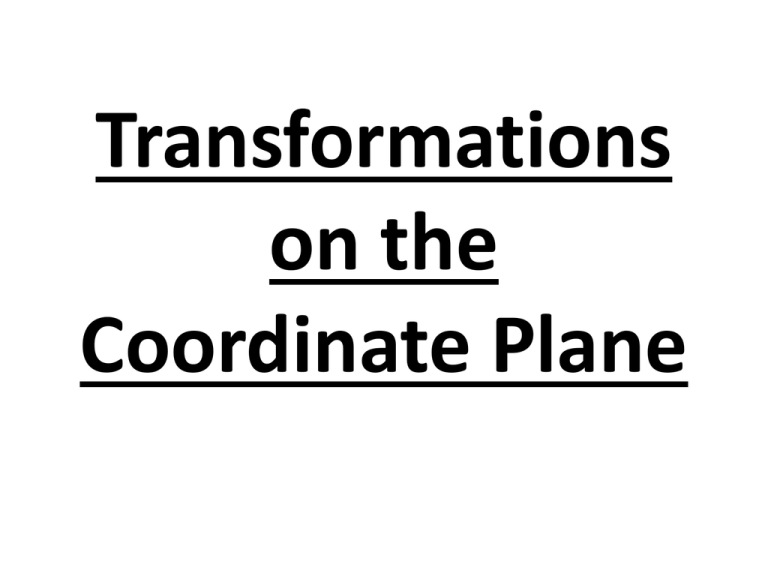
Transformations on the Coordinate Plane Learning Target I CAN transform figures on a coordinate plane by using reflections, translations, dilations, and rotations. Transform Figures A transformation is an operation that maps an original geometric figure, the pre-image, onto a new figure called the image. Look at Example 1 on page 197 for information on the different types of transformations: reflection, translation, dilation, and rotation. Transformations on the Coordinate Plane You have 12 minutes to copy down the entire “Key Concept Transformations on the Coordinate Plane” on page 198. All of the information is VERY IMPORTANT and really needs to be in your notes for future reference!!! Reflection: A Figure is Flipped Over a Line A reflection is a mirror image of the original figure. It is the result of a transformation of a figure over a line called a line of reflection. In a reflection, each point of the pre-image and its image are the same distance from the line of reflection. So, in a reflection, the image is congruent to the pre-image. Reflection A parallelogram has vertices: A(-4, 3), B(1, 3), C(0, 1), and D(-5, 1). A. Parallelogram ABCD is reflected over the x-axis. Find the coordinates of the vertices of the image. Reflection To reflect the figure over the x-axis, multiply each y-coordinate by -1. (x, y) = (x, y times (-1)) = (x, -y) A(-4, 3) = (-4, 3 x (-1)) = A’(-4, -3) B(1, 3) = (1, 3 x (-1)) = B’(1, -3) C(0, 1) = (0, 1 x (-1)) = C’(0, -1) D(-5, 1) = (-5, 1 x (-1)) = D’(-5, -1) Reflection The coordinates of the vertices of the image are A’(-4, -3), B’(1, -3), C’(0, -1), D’(-5, -1) B. Now graph parallelogram ABCD and its image A’B’C’D’. Translation: A Figure is Slid in Any Direction A translation is a transformation that slides a figure from one position to another without turning it. In a translation, the image and the pre-image are congruent. Translation Triangle ABC has vertices: A(-2, 3), B(4, 0), C(2, -5). A.Find the coordinates of the vertices of the image if it is translated 3 units to the left and 2 units down. Translation (x, y) = (x – 3, y – 2) = (x’, y’) A(-2, 3) = (-2 – 3, 3 – 2) = A’(-5, 1) B(4, 0) = (4 – 3, 0 – 2) = B’(1, -2) C(2, -5) = (2 – 3, -5 – 2) = C’(-1, -7) B. Now graph triangle ABC and triangle A’B’C’. Dilation: A Figure is Enlarged or Reduced A dilation is a transformation that enlarges or reduces a figure by a scale factor. Since the figure is enlarged or reduced by a scale factor, the pre-image and the image are similar (not congruent!!!) figures. Dilation A trapezoid has vertices: L(-4, 1), M(1, 4), N(7, 0), P(-3, -6) A.Find the coordinates of the dilated trapezoid L’M’N’P’ if the 3 scale factor is . 4 Dilation To dilate the figure multiply the 3 coordinates of each vertex by : 4 (x, y) = 3 3 ( 𝑥, 𝑦) 4 4 Dilation 3 L’( 4 3 𝟑 L(-4, 1) = ∙ (-4), ∙ 1) = L’(-3, ) 4 𝟒 3 3 𝟑 M(1, 4) = M’( ∙ 1, ∙ 4) = M’( , 3) 4 4 𝟒 3 3 N(7, 0) = N’( ∙ 7, ∙ 0) = N’(5.25, 0) 4 4 3 3 P(-3, -6) = P’( ∙ (-3), ∙ (-6)) = P’(-2.25, -4.5) 4 4 B. Now graph trapezoid LMNP and its image trapezoid L’M’N’P’. Rotation: A Figure is Turned Around a Point A rotation is a transformation in which a figure is rotated, or turned, about a fixed point. The center of rotation is the fixed point. A rotation does not change the size or shape of the figure. So, the pre-image and the image are congruent. Rotation Triangle XYZ has vertices: X(1, 5), Y(5, 2), and Z(-1, 2) A. Find the coordinates of the image ∆XYZ after it is rotated 90° counterclockwise around the origin. Rotation To find the coordinates of the vertices after a 90° rotation, switch the coordinates of each point and then multiply the new first coordinate by -1. (x, y) = (y ∙ (-1), x) = (-y, x) Rotation X(1, 5) = (5 ∙ (-1), 1) = X’(-5, 1) Y(5, 2) = (2 ∙ (-1), 5) = Y’(-2, 5) Z(-1, 2) = (2 ∙ (-1), -1) = (-2, -1) B. Now graph ∆XYZ and its rotated image ∆X’Y’Z’
